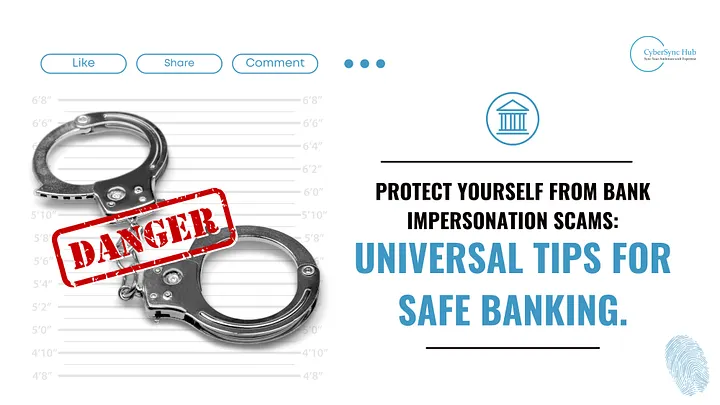With the rise of digital banking and ongoing system upgrades, banks worldwide are working to provide faster and more secure services. Unfortunately, scammers are quick to exploit these transitions, tricking
users into sharing personal information through impersonation tactics. Here’s how you can protect yourself from bank impersonation scams, no matter where you bank.
Understanding Bank Impersonation Scams: How They Work.
- Fake Communications: Scammers often send texts, emails, or calls that mimic official bank messages. These communications claim to resolve issues related to new features, recent upgrades, or unusual account activity.
- Exploiting System Transitions: When banks undergo upgrades or new security implementations, there may be temporary delays or adjustments in services. Scammers take advantage of this period to
convince people that they need “assistance” or “verification” to keep their accounts secure. - Spoofing Trusted Sources: Cybercriminals can fake caller IDs and email addresses to make their messages look like they’re coming from a real bank. This increases the chances that people might trust the communication and share sensitive information.
Common Scams to Watch Out For.
- Fake Login Links: Scammers may send messages prompting you to “log in” through a link that leads to a fraudulent website designed to steal your login credentials. The site may look almost identical to your bank’s real site.
- Verification Scams: Posing as bank representatives, scammers may ask you to “re-verify” details like your account number, PIN, or password information that legitimate banks will never request via email, text, or over the phone.
- Technical Support Scams: Impersonators may contact you claiming to resolve a banking issue, but they ask for sensitive details or access to your device, often leading to financial loss.
Signs of a Bank Impersonation Scam.
- Urgent Language: Messages that demand immediate action or claim “your account will be locked” are often scams designed to pressure you into reacting quickly.
- Unknown Senders or Strange URLs: If the sender’s email address looks off (e.g., a slight spelling error or unexpected domain) or the URL doesn’t match your bank’s official website, it’s likely fraudulent.
- Requests for Passwords or Full PINs: Banks may ask for specific digits of your PIN if you call them, but they will never request the full PIN or your password over email or text.
- Attachments or Links: Be cautious of any email attachments or unsolicited links, as these can contain malware that compromises your device’s security.
Steps to Take if You Suspect a Scam.
- Report It to Your Bank Immediately: Contact your bank’s fraud department to inform them of the suspicious message. This helps banks stay aware of current scams and inform other customers.
- Update Your Security Information: If you’ve accidentally provided information to a scammer, change your bank passwords and update any security settings, such as PINs or security questions, as soon as possible.
- Monitor Your Financial Activity: Check for any unauthorized activity and set up alerts, if available, to be notified of transactions in real time.
Tips for Staying Safe from Bank Impersonation Scams.
- Verify Any Message: Always confirm communication by contacting your bank directly. Use contact details from official bank websites or banking apps, never rely on phone numbers or links provided in unexpected messages.
- Avoid Clicking on Links in Messages: Instead of clicking on links, type the bank’s URL directly into your browser. This helps you avoid phishing sites that look authentic but are designed to steal your information.
- Enable Multi-Factor Authentication (MFA): Using MFA adds an extra security step, often a code sent to your phone or email, to verify your identity when logging in. Even if scammers get your login details, MFA makes it harder for them to access your account.
- Be Cautious with Personal Information: Banks will never ask for sensitive information like passwords or full account numbers through email or text. If someone requests this information, it’s a red flag.
- Regularly Check Your Accounts: Frequently monitor your bank accounts for any unauthorized transactions. This can help you spot issues early and take quick action if something appears suspicious.
Bank impersonation scams are a global issue, but staying informed and vigilant can protect you from falling victim. Always verify unexpected communications, avoid sharing sensitive information, and use enhanced security measures like MFA and transaction alerts. Remember, banks are committed to protecting your assets and will never request confidential information through insecure channels. By following these universal tips, you can enjoy safer and more secure banking experiences, no matter where you are.


